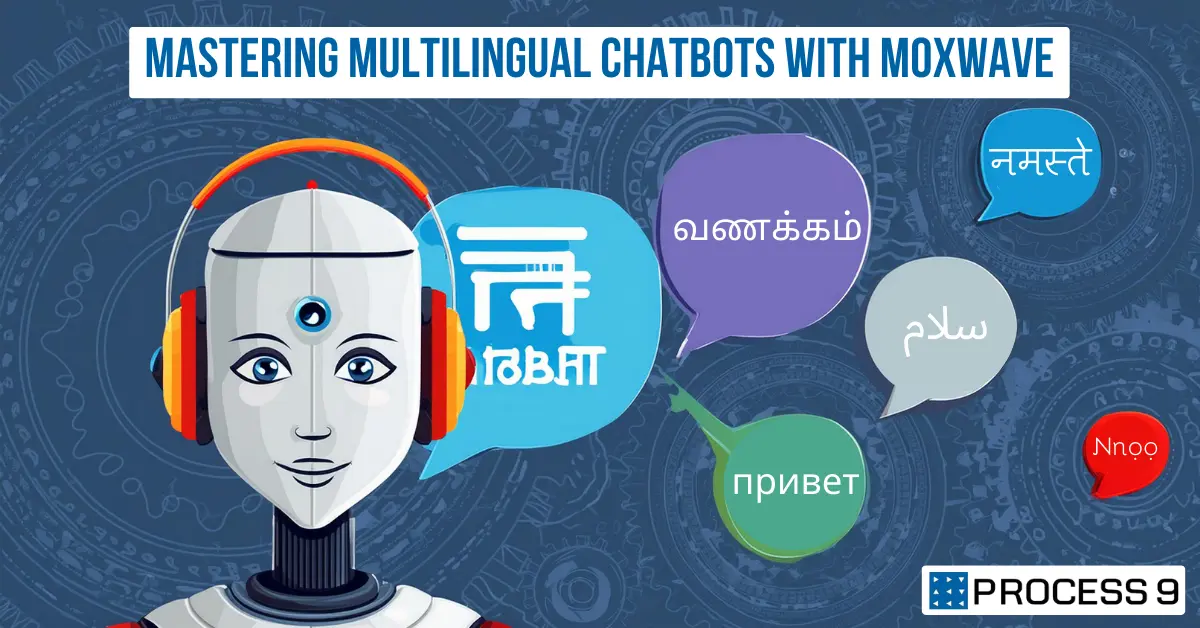With the prominence of conversational AI in the digital world, multilingual chatbots have become indispensable for businesses. As businesses thrive to expand beyond borders, multilingual communication is essential to connect with customers better. However, developing and maintaining a multilingual chatbot has its own challenges.
In this blog, let’s dive deep into different types of multilingual chatbots, the challenges they present, and how MoxWave, the best-in-class chatbot localization solution from Process Nine, can overcome these hurdles.
Types of multilingual chatbots
There are different types of multilingual chatbots and each comes with unique features that can befit its use cases. Based on its use cases, some of the common types of multilingual chatbots are,
- Translational chatbot
- Entertainment chatbot
- Language learning chatbot
- Transactional chatbot
- Informational chatbot
- Customer support chatbots
The translational chatbots are mainly used for translating texts from one language to another. Entertainment chatbots offer entertainment-related content in multiple languages for its users. Language learning chatbots are used to practice speaking, collect feedback, and learn slang and colloquial speech in a variety of languages. Transactional chatbots allow users to manage customer-company transactions in the language of their choice. Informational chatbots provide users with precise information in real-time using databases and other reliable sources. Customer support chatbots interact with customers in real-time via chat or messaging to provide automated support and assistance.
Challenges of Multilingual Chatbots
Linguistic variations
Each language has its distinct dialect, accent, and regional specialties that are emphasized within it. The meaning of the texts might not be conveyed if they were translated word for word without taking these aspects into account.
Cultural nuances
A region’s language and culture are closely related to one another. If a message is spread without taking into account the subtle cultural differences in that area, it could offend people and cause misunderstandings. The responses of the chatbots need to be tailored accordingly to maintain a positive user experience.
Consistency across languages
When a chatbot handles queries in multiple languages, it can be challenging to maintain consistency in tone, style, and branding across all of them. The credibility of the chatbot might be at stake if consistency cannot be maintained.
Contextual understanding
A multilingual chatbot should be able to understand the context of each query from each language. This is important to generate prompt, relevant, and accurate responses. If the bot delivers just translated content without understanding the context, the result would be incorrect.
Updates and monitoring
It is possible that additional languages will be added to the chatbot as the business grows. Chatbots must be updated frequently to account for changes in language usage, emerging trends, new languages, and newly added products or services to the company.
How can an effective chatbot localization solution overcome the challenges?
Advanced Natural Language Processing (NLP)
A robust chatbot localization solution uses Natural Language Processing (NLP) algorithms to understand the variations in multiple languages and its associated dialects, accents, regional nuances, etc. With a thorough analysis of patterns and context, these chatbot localization platforms can provide precise outputs that are contextually appropriate.
Cultural Adaptation
A multilingual chatbot should take the cultural nuances of each language into account. Even though they might be slight, these cultural differences should be taken into account when curating the bot’s responses in each language.
Content Management System
Multilingual content can be efficiently managed using a robust content management system. A chatbot localization solution should be able to be integrated with CMS platforms so that businesses can update and maintain content across multiple languages through a single interface.
Machine translation with human oversight
A well-trained machine translation engine is an integral part of chatbot localization. In addition, human review may be required in some places to guarantee the content’s linguistic and cultural correctness as well as its contextual appropriateness.
Continuous updates and monitoring
Chatbot localization solutions have tools that can monitor various aspects of the bot, like its performance in each language, user interactions, user response time, etc. These tools will help businesses identify areas for improvement that can improve the chatbot.
Also read: Need of Chatbot localization in Indian languages
How can MoxWave help you?
Process Nine Technologies offers MoxWave, an easy-to-use chatbot localization solution. If your company is looking to provide personalized chatbot experiences in a variety of languages, look no further. MoxWave can communicate with customers regardless of the type of chatbot. MoXWave’s robust language detection and understanding capabilities enable it to engage customers in innovative ways, whether through a menu-based chat or live chat. Text translation is done with a clear understanding of the user’s preferences and preferred language. MoxWave can be easily integrated with any CMS platform, social media channel, or chatbot platform, such as WhatsApp.
To learn more on how MoxWave can help you master multilingual communication with your customers, Contact us today







Share: